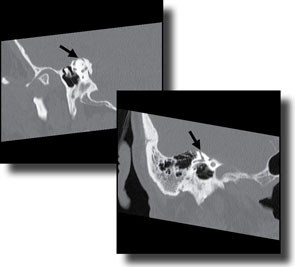
Explore This Issue
January 2011A 71-year-old male presented with an approximately 10-year history of a gradually progressive right-sided hearing loss. He had significant noise exposure history having been in the Navy for 30 years, often on aircraft carriers, with his bunk beneath the flight deck. He denied any history of significant childhood ear disease, ear surgery/trauma or family history of hearing loss. He denied any dizziness, imbalance or vertigo. He had no autophony or sound/pressure-related dizziness. On physical examination, both tympanic membranes revealed only mild, diffuse myringosclerosis. He had a shallow retraction pocket superiorly in his right tympanic membrane. Both middle ears appeared well aerated. His audiogram revealed bilateral sloping symmetric sensorineural hearing loss (SNHL) with a large superimposed, low-frequency conductive component on the right. His speech discrimination scores were appropriate, and tympanograms were type A. His acoustic reflexes (500, 1000, 2000 Hz) were present bilaterally.
How would you manage this patient? Go to the next page for discussion of this case.
Leave a Reply